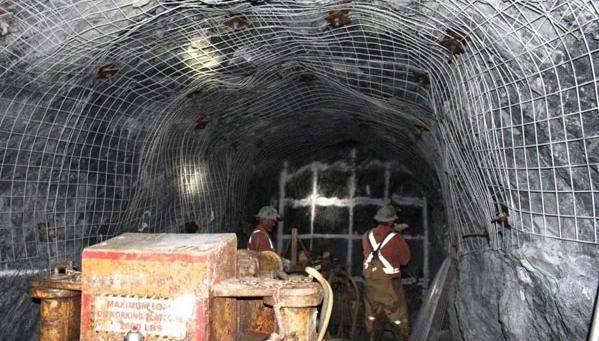The Phoenix gold project involves the development of an underground mine in the Red Lake district of Ontario, Canada, which is one of the largest gold producing countries in the world.
Rubicon Minerals Corporation (Rubicon) fully owns the gold mine, which it acquired from Dominion Goldfields Corporation in 2002, subject to a 2% net smelter return (NSR) royalty to Franco-Nevada.
Rubicon Minerals entered an agreement with RGLD Gold for the sale of gold produced at Phoenix in February 2014, with RGLD Gold investing $75m into the project and will receive 6.3% of the gold until the 135,000oz production milestone. Royal Gold will then receive 3.15% of the projected annual gold production.
The underground gold project started stockpiling the mineralised material in December 2014 and commenced production in June 2015.
Rubicon, however, suspended the underground activities at the Phoenix gold project in November 2015 to enhance geological model of the F2 gold deposit and develop the Phoenix Project Implementation Plan (PPIP).
A modified mineral resource estimate and an enhanced geological model were unveiled in January 2016, which significantly reduced the indicated mineral resource estimate by 88%. Activities related to the PPIP were also suspended as a result of the steep drop in estimated resources.
Rubicon plans to conduct further exploration at the project during 2017 and 2018 to delineate additional resources. Trial mining is planned to be conducted in mid-2018, while updated mineral resource estimation is expected be announced in the second half of 2018. A decision to conduct potential feasibility study will be taken depending upon the outcomes of the exploration.
Phoenix gold project location and geology
The Detour Lake mine is a gold deposit located 8km west of the Ontario-Québec border in Canada.
The Phoenix gold project is located in the south-western region of Bateman Township within the Red Lake mining district. It lies in the Uchi sub-province of the Superior Province of the Canadian Precambrian Shield. The Uchi sub-province contains the Red Lake Greenstone Belt, one of Canada’s leading gold producing districts.
The mining district features tholeiitic and komatiitic metabasalts of the Balmer Assemblage. Three mineral sequences, comprising mostly tholeiitic mafic volcanic rocks, are found at the Balmer Assemblage and form the host rocks for the gold project.
Gold mineralisation is characterised by vein and sulphide replacement styles. The gold system also comprises intense potassic alteration (biotite), along with variable amounts of carbonate, silica alteration, and quartz-carbonate veining.
Gold reserves at the Phoenix project
As of June 2013, the Phoenix mine was estimated to contain measured and indicated mineral resources of 4.12 million tonnes (Mt) of ore grading 8.52g/t of Au. It was estimated to contain 1.13Moz of gold, with inferred resources projections of 7.45Mt containing 2.21Moz of gold.
The estimate was revised in January 2016 to indicate mineral resources of 492,000t of ore grading 6.73g/t Au, while contained gold is estimated to be 106,000oz, a drop of 91% compared to the 2013 estimate.
The significant decrease is attributed to new drilling information, changes in the modelling approach, and constraints to the depth of gold mineralisation. The high-grade mineralisation was found to be less continuous than initially understood, leading to a steep drop in the mineral estimate.
Mining and processing of gold at Red Lake, Ontario
Longhole open stoping methods were primarily used at the underground gold project, while cut and fill mining methods were implemented at areas with irregular shape. Approximately 90% of life of mine (LoM) production was expected to come from longhole operation and the remaining from cut-and-fill. The mine was estimated to have a maximum production rate of 2,250 tonnes per day (tpd), based on 2013 estimates.
The mineralised material is crushed underground by a jaw crusher and hauled to the surface either by load-haul-dump (LHD) units or trucks. Stopes are backfilled with development rock wherever possible.
A semi-autogenous grinding (SAG) mill is used at the processing plant. The discharge from the SAG mill is sent to the ball mill circuit. The mill circuit is arranged with hydro-cyclones in closed circuit and comprises a gravity separation circuit, which recovers and concentrate any gravity recoverable gold.
The remaining gold is extracted in a conventional carbon-in-leach (CIL) circuit. Gold is recovered from the loaded carbon by elution (stripping) followed by electro-winning. Electro-winning and the gravity circuits will produce high-grade gold concentrates for smelting into doré.
In June 2015, Rubicon Minerals Corporation commissioned a cyanide detox system supplied by Gekko Systems for Phoenix Gold Project. The system employs the proven SO2/Oxygen (INCO) process to destruct cyanide in the leach tails, decreasing it to less than 1ppm weak acid dissociable (WAD) cyanide.
Production
The first gold of approximately 741oz was successfully poured at the mine in June 2015 and 4,906oz of gold was produced until December 2015.
The project was estimated to have a mine life of 13 years. Approximately 2.19Moz of gold was expected to be produced, with an average annual production of 165,300oz over its lifetime, based on the 2013 resource estimate.
Phoenix gold project financing
In addition to Royal Gold’s $75m contribution, the project is being funded through a C$12m flow-through financing, C$108m equity, and C$15m lease funding.
Construction and infrastructure facilities
Major works at the Phoenix project site included the construction of mill, tailings management facility, crushed ore bin, drive trains for the ball and SAG mills, CIL tank, mill thickener, and cyanide destruction circuits. The project also included the installation of Knelson concentrators, and stairwells.
Hydro One supplies 5.3MVA of power to the Phoenix gold project. An electrical substation with operational capacity of 7.5MVA operates at the mine site.
Key players involved with Phoenix gold project
SRK Consulting was contracted to prepare the preliminary economic assessment (PEA) report for the gold project. AMC Mining Consultants and Soutex prepared the PEA for the F2 gold system.
The contract for conducting underground drilling at the gold project was awarded to Orbit Garant in June 2009. Layne Christensen Canada was engaged to complete deep boreholes for the project.





